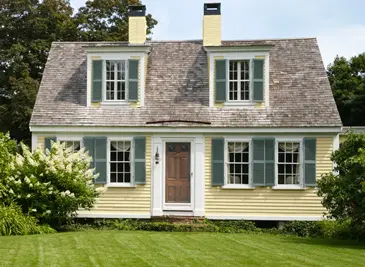Learn Your Home’s Architectural Roots from Benjamin Moore

Cape Cod
(1600-1955) Cape Cods are one of the oldest traditional American architectural home styles.
Early colonists in New England modeled the Cape Cod style after the countryside homes they left behind in England. The beautiful simplicity of Cape Cod design complements the style’s sturdy structure, which was built to withstand harsh, New England winters. Classic Cape Cod style homes are modest 1-story dwellings with dormers (windows set vertically on a sloping roof, which have their own small roofs). The windows on a Cape Cod are multi-paned and double-hung with shutters. These homes have a center hallway, one or more fireplaces, and hardwood floors.
Dutch Colonial
(1625 – mid 1800’s) As the early Dutch settlers made their homes along the Hudson River in New York State, they built brick and stone homes that were reminiscent of those found in the Netherlands.
Original Dutch Colonial homes are not “true” colonial style homes – the name references the Dutch colonists that settled here. However, Dutch Colonial Revival style is a type of colonial style, blending elements of Colonial Revival and Dutch Colonial style homes. One of the most distinguishing features of a Dutch Colonial style home is the gambrel roof. The gambrel has four slopes; two at the top with a slight pitch, then another two along the sides that are longer, steeper and have a distinctive “flipped” edge. Original Dutch Colonial style homes included dormers which allowed homeowners the advantage of having almost an entire second floor without the construction costs and taxation levied on a two-story home. Other identifying features of Dutch Colonial style homes include clapboard or shingle siding, sometimes with a stone or brick front, small, round windows in the gable end, 8 over 8 windows, gable-end chimneys, and columns for porches and entries. Porches were usually placed under overhanging eaves, and while the overall shape of the home is symmetrical, many also have side entrances.
Lodge
(1630-1880, 1930-present) Most often seen in the Midwest and southern mountain regions of the United States, log cabin style homes were popular until the mid-nineteenth century.
Abundant evergreen forests in Northern Europe inspired immigrants who were from those areas to bring their homebuilding skills with them to America. Today, modern log-style homes are still popular in many resort areas in the mountain regions of the west and south.
The solid construction of log style homes makes them warm shelters from the harsh elements of cold, windy climates. Classic construction of these homes did not include nails. The logs were notched to fit together snugly, then any gaps that remained were tightly packed with fill that could include mud, sticks, and wood chips, also called chinking. Any opening such as windows and doors, were kept to a minimum to preserve heat. The main source of light and heat in traditional log homes came from the fireplace. Today’s log style homes have abundant windows, inviting natural light and beautiful views into the homes’ living areas.
Victorian
(1860 – 1910) There are numerous styles of Victorian architecture, and many Victorian style homes often include design elements from several of these styles.
The most elaborate of Victorian style homes were built between 1880 and 1890, during the then burgeoning Industrial Revolution.
Generally, Victorian style homes have an overall asymmetrical shape, with a pitched and irregular roof. Spindles on the porch posts are elements attributed to the Eastlake Victorian style, so named after the similarly styled furniture of famed English designer Charles Eastlake.
Queen Anne Victorian features are varied and can include bay windows, balconies, stained glass, turrets, porches, brackets and abundant details.
Colonial
(1876-1955) Colonial style homes remain one of the most popular of what we consider classic American designs.
There are numerous home styles within the Colonial design genre, including Colonial Revival, Georgian Colonial, Federal style and Greek Revival. Many Colonials have several design elements from these various styles incorporated into a single home design.
Colonial style homes are identified by their overall rectangular shape and symmetrical façade. Windows are multiple-paned and double-hung, often with shutters and, sometimes, dormers. Dormers are windows that are set vertically on a sloping roof, with their own small roof above them. Colonial style homes are typically 2 or 3 stories, with brick or wood siding. A paneled front door is often surrounded by side lights (narrow windows) and canopied by a portico topped by a pediment, which is a low-pitched gable.
Tudor
(1890-present) Tudor style homes reached a peak of popularity in the 1920’s and 1930’s and again in the 1970’s and 1980’s.
The architectural features of Tudor style homes evolved from medieval times. Such homes were constructed in a post and beam fashion, with roughly hewn lumber, and finished with plaster between the posts. While today’s Tudor style homes aren’t typically built in such post and beam construction, the look of these homes has been copied.
Tudor style homes typically have complex and steep roof lines, with plaster, stucco and sometimes stone or brick façades. Detailing includes “half-timbering” which are strips of wood frames on masonry that form a pattern. Tudor style homes also often have multiple chimneys that are both tall and wide and are typically topped with a decorative, round top. Windows are tall and narrow – some with leaded glass – and doorways are low and arched.
Ranch
(1920-1970) Also known as a California Ranch, ranch style homes hit their height of popularity between the 1940’s and 1970’s.
With their clean lines, low to the ground profiles and unadorned exteriors, ranches were a blend of both modern and western styles. They reflected a shift in lifestyles from formal to casual, and celebrated the burgeoning desire to move out of the city to the more spacious suburbs.
Ranch style homes include a low pitched roof, deep-set eaves, large double-hung windows with a sizable picture window in the front, and sliding doors that open out onto a patio. Ranch style homes are typically 1 level, and have a rectangular shape with no basement.
Contemporary
(1965- Present) “Contemporary” can be a relative term, since it refers to a period of time that is conditionally “recent” — a measure of time that is not fixed.
Architecturally speaking, Contemporary style homes have specific characteristics. Two styles of home often referred to as Contemporary include Post Modern and Neo Eclectic. While these two styles share many Contemporary elements, each has its own unique design, separate from the Contemporary style.
A true Contemporary style home has large, tall panes of glass for windows, which can be rectangular and sometimes trapezoidal. Typically, the overall shape of a Contemporary style home is irregular, lacking any real exterior ornamentation. Natural materials, such as stone, are often used to harmonize with nature, and most have flat or gabled roofs. Post Modern styles have greatly exaggerated modern elements, while Neo Eclectic styles infuse historic details into modern design – something you’ll never see in true Contemporary style.










